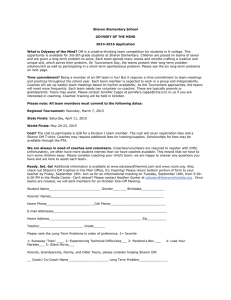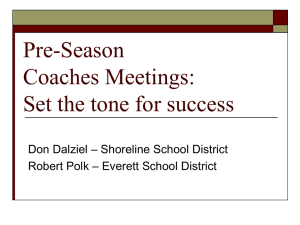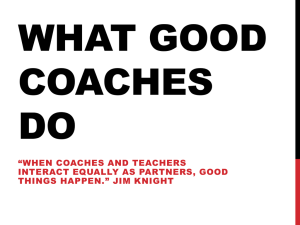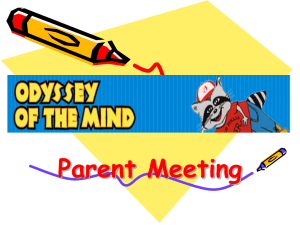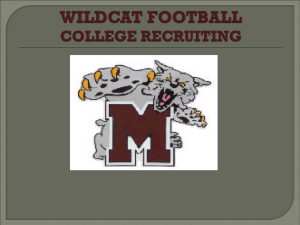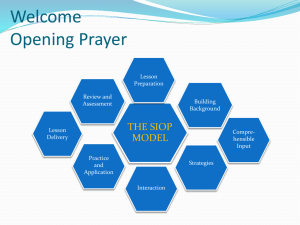OM Briefing / Info 2014 - 2015
advertisement
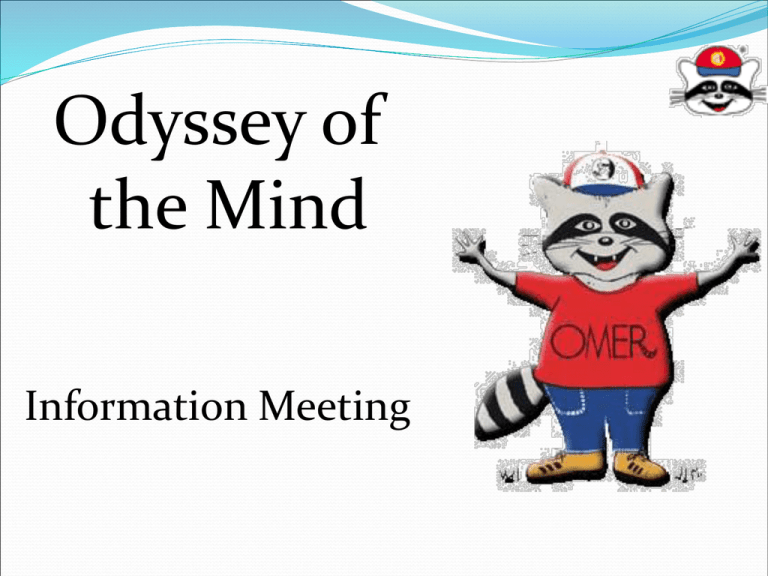
Odyssey of the Mind Information Meeting OVERVIEW Definition Benefits Participants Competition/Kinds of Problems Sequence Requirements Team Formation 2014-2015 Problems Important Dates Conclusion WHAT IS OOTM? An international educational program/competition which provides creative problem solving opportunities for students, Kcollege BENEFITS Participants learn: Team-building skills by working in groups How to effectively brainstorm How to identify the real challenge How to seek out-of-the-box solutions How to think on their feet How to present solutions and answers in a large group setting How to “open up” and express themselves How to work independently PARTICIPANTS ANY student in grades Kindergarten through college Division 1: K-5th grade K- 2 does Primary Problem Division 2: 6th through 8th grade Division 3: 9th through 12th grade Division 4: College students COMPETITION Preparation begins in September (or earlier if team stays together) for March regional competition Consists of two parts: Long term problem Select one from five types; Primary Problem Spontaneous problem LONG TERM PROBLEMS (5 kinds) Mechanical/Vehicle: Teams design, build and operate vehicles of various sizes and with various power sources LONG TERM PROBLEMS Technical Performance: Teams make innovative contraptions and incorporate artistic elements into their solutions. LONG TERM PROBLEMS Classics: Teams write and perform skit based upon the classical -- from literature to architecture to art. LONG TERM PROBLEMS Structure: Teams design and build structures using only balsa wood and glue which are weight tested. LONG TERM PROBLEMS Performance: Teams present performances that revolve around a specific theme and incorporate required elements. LONG TERM PROBLEM GUIDANCE Places multiple constraints on the team which they must consider as they develop their solution. Examples for performance: Must be done 8 minutes or less Must be done in a presentation area not larger than 7 feet by 10 feet Is judged in many areas Could garner penalty points for a variety of infractions SPONTANEOUS PROBLEMS Verbal Verbal Hands-On Hands-On SEQUENCE Parents/students attend orientation (May/June & August/September) Students choose problem/coaches volunteer Teams form/formed Meetings held (September through March) School registers for competition (January) Teams practice/dry run (February-March) Teams compete at Regional level (March) REQUIREMENTS School membership fee ($135/first team, $100/addl teams) Coaches Places to meet Funds for long term problem ($125-$145/team) Competition registration fee ($60/team) One Judge and One volunteer from each team < $50/student to participate (CEUs for teachers) COMMITMENT Students TIME Hard work Open mind Positive attitude Encouragement Creativity Punctuality Sense of humor Teamwork Respect Parents Funds Time Punctuality Planning TEAM FORMATION Teams consist of 5 to 7 members Teams form in many ways throughout US: Gifted (as defined by the school district) Try-out Test Lottery Coaches choose Coaches form Coordinator forms Students form Teachers form TEAM FORMATION Method is School’s choice NOTE: Recommend school coordinator not guarantee placement of any student on a team unless that student’s parent or guardian is a coach. 2014-2015 PROBLEMS MECHANICAL/VEHICLE Problem 1: Runaway 'Train' Divisions I, II, & III The team’s problem is to design, build and operate one or more vehicles that will travel on tracks and make stops at different stations without touching the floor. While traveling between stations, the vehicles must overcome obstacles —moving uphill, towing something, and more. The theme of the performance will explain the vehicle’s difficulties on the track and will include a ‘conductor’ character. Once the vehicle reaches its final destination it will display a flag or banner during a victory lap! Cost limit: $145 USD. TECHNICAL Problem 2: Experiencing Technical Difficulties Divisions I, II, III, & IV The problem is to design, build, and demonstrate various devices that complete specific tasks. The team will create a theme where technical failures must be resolved through completing the tasks. There will be a list of tasks to choose from including ring a bell, change the wording on something, sound an alarm, move an object, etc. There will also be a mysterious engineer character. Of course, there’s a twist — all of the devices must be powered by rubber bands! Cost limit: $145 USD. CLASSICS Problem 3: Pandora’s Box Divisions I, II, III & IV In this classics problem, teams will put a video game spin on the story of Pandora’s Box. A gamer character will take on this multi-level game inspired by the Greek myth. The game will include a prologue that depicts the original story of Pandora’s Box, three characters representing different evils that escaped the box, and a power meter that represents the gamer character’s health. To beat the game, the player will advance to the final level where it will release hope into the world. Cost limit: $125 USD. STRUCTURE Problem 4: Lose Your Marbles Divisions I, II, III & IV This problem requires teams to design, build, and test a structure, made only of balsa wood and glue, that will balance and support as much weight as possible. The structure will also hold five marbles that will be released during weight placement as a result of a team-created device removing a piece of the structure. After the crusher board and one additional weight are placed on top of the structure, the first marble will be released. After the next weight is supported, the team will use its device to release another marble, and so on. The team will incorporate weight placement and “losing your marbles” into the theme of the performance. Cost limit: $145 USD. THEATRICAL Problem 5: Silent Movie Divisions I, II, III & IV Lights, camera...action! In this problem teams will create and present a performance depicting a Director character that produces and presents a silent movie featuring a humorous villain character that commits three silly acts of “villainy”. Characters that are in the movie may not speak as part of the presentation of the movie. Instead, like classic silent films, the team will use music played on a team-created instrument and creatively displayed subtitles to convey its story to the audience and judges. Also, teams will use a signal to indicate when the movie begins and ends. Cost limit: $125 USD. Primary Primary: Wacky Weather Warning Grades K-2 Teams will create and present a humorous performance where a meteorologist makes three predictions of “wacky weather”. The meteorologist will speak in rhymes and use a team-created forecasting device and a backdrop that serves as a weather map. The community will “tune in” to get the weather report in any creative way the team wishes. Cost limit: $125 USD. IMPORTANT DATES Problems Released: During first full week in September Coaches’ Training: Oct 25, 2014 (Freedom HS, South Riding) Mandatory for new coaches T-shirt Design Submissions: TBD Spontaneous Coaches’ Workshop: Dec 6, 2014 (Park View HS, Sterling) Regional Tournament Registration: 6 Dec-6 Jan, with payment via MAIL only T-shirt Orders Due: TBD, with payment via MAIL only Judges’ Training: Feb 7, 2015 (Park View HS) Regional Competitions: Catoctin Region 14: Saturday, Feb 28, 2015 (John Champe HS, Aldie) Dulles Region 16: Saturday, Mar 14, 2015 (Park View HS Snow Date for either region: Saturday Mar 21, 2015 (J. Champe HS) State Competition: Saturday, Apr 18, 2015 (South County HS, Lorton) World Competition: 21-23 May 2015, Michigan State University CONCLUSIONS OOTM is an excellent program given benefits realized. An OOTM program is only limited by the number of coaches available. Students who compete are all winners no matter where they place in competition. Questions? Backup Slides ORIGINATION Developed by Dr. Sam Micklus, professor at Rowan University Challenged his students to create vehicles without wheels, mechanical pie throwers and floatation devices to travel across a lake. Evaluated solutions not only on success but on ingenuity applied and risks taken. Students had FUN, word spread and people outside the college “wanted in.” Led to the development of this world-wide creative problem solving competition. VERBAL Example Name things that are “red” Student should think of all of the definitions of “red,” i.e.: an apple a newspaper Ready at the Switch bread and butter red skies at night A map blood ready, set, go Gingerbread Giant redwoods Readiness VERBAL HANDS-ON Example Team is given any number of group of materials/things: PIECE OF STRING, 2 PENCILS, COFFEE FILTER, MEAT BASTER, 6 PAPER CLIPS, 2 MARBLES, PAPER CUP, PAPER PLATE, 12" SQUARE OF ALUMINUM FOIL, 24" PIECE OF YARN, RULER OR YARDSTICK, NAPKIN (PAPER OR CLOTH), 2 RUBBER BANDS, BUSINESS-SIZE ENVELOPE, 6 MARSHMALLOWS, SHEET OF PAPER, 3 COTTON BALLS, PLASTIC SPOON, BALLOON, TENNIS BALL, TOOTHBRUSH, COIN, PLASTIC BAG, HAT, SURGICAL MASK, CLOTHES PIN, ERASER ETC. Each member chooses three items Team is told items are clues uncovered from a previously unknown civilization Each must describe how those objects may have been used in that civilization’s way of life. Example: Meat baster may have been used to water plants in a greenhouse. HANDS-ON Example Usually the most difficult Each team is given 40 pieces of spaghetti, 15 pieces of elbow macaroni, 25 miniature marshmallows, 10 toothpicks, 4 straws, and 5 adhesive mailing labels, 5 pounds of penny nails and a pint size plastic container. Team has 7 minutes to make a structure and 2 minutes to test it. They may talk during build. HANDS-ON Example (continued) Structure is scored on height and strength. Must rest on the surface of the table and may not lean against a wall or be supported by anything else. After completed team must place the container on top of structure. Judges will measure height from the surface of the table to the top of the container. Must be at least 8 inches high to receive score. HANDS-ON Example (continued) Once measured team must begin placing weights in container, one at a time. Weight must be held for 3 seconds to count for score. Problem is finished when structure breaks, when all the weights have been used, or when time ends.

